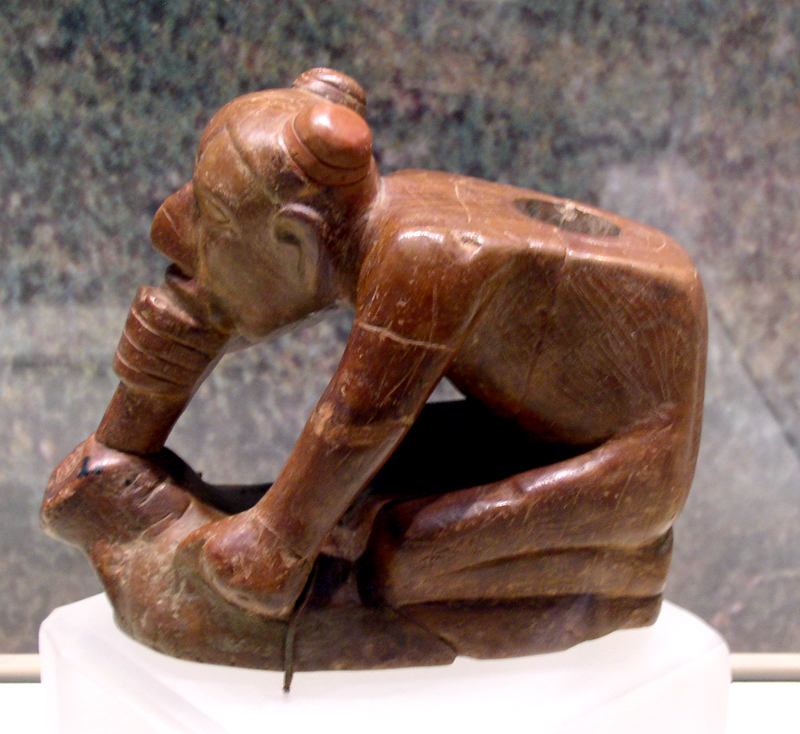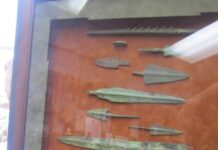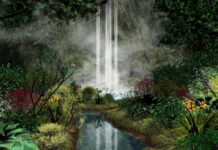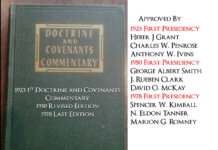Natives only had One God- Great Spirit
The Hopewell and Adena people had a strong religious affinity. The way they lived may seem unlike what we think of today, but in their own way they believed in “One God” or the “Great Spirit” and He was a central role in their lives. We know the Jaredites lived the gospel in righteousness for many years, as did the Nephites and Lamanites. In Ether 20 we read, “so great was his faith in God, that when God put forth his finger he could not hide it from the sight of the brother of Jared, because of his word which he had spoken unto him, which word he had obtained by faith.”

Ammon converted many of the Lamanites as we read in Alma 19:35-56, “And it came to pass that there were many that did believe in their words; and as many as did believe were baptized; and they became a righteous people, and they did establish a church among them. And thus the work of the Lord did commence among the Lamanites; thus the Lord did begin to pour out his Spirit upon them; and we see that his arm is extended to all people who will repent and believe on his name.”
The Ancient Hopewell and Adena utilized the pipe and tobacco as a way to worship the Great Spirit.
It is interesting to note… that I know of no Indian language in which one can take the name of the Lord in vain. Indeed, I do not know of an Indian language in which they can even swear. They have to learn English or some white man’s language before they can defile the name of Deity.” LAMANITE TRADITION by Golden R. Buchanan PRESIDENT, SOUTHWEST INDIAN MISSION IMPROVEMENT ERA APRIL 1955
Sacred Medicines
In the Indigenous culture, there are four sacred medicines: tobacco, cedar, sage, and sweetgrass. Of these, tobacco is the most widely known, but despite the broad usage of commercial-tobacco products, the general public knows very little about tobacco’s traditional uses and its importance to the Indigenous culture.
Indigenous peoples from around the world have used tobacco for hundreds of years as a means of connecting with the Creator, Mother Earth, the Spirits, and one another. Here, you’re going to learn everything you need to know to start having informed conversations on tobacco, including its traditional uses in ceremonies and for sacred rituals.
Tobacco is considered the most sacred of the Indigenous sacred medicines, used in virtually every ceremony as a means of connecting directly to the Creator. Tobacco is also thought to be the first plant given to the Indigenous people by the Creator. Because of this, tobacco is most frequently used as an offering, either in order to give thanks, to make a request for wisdom or protection, or as a means of cleansing.
SMUDGE CEREMONYWITH NATIVE MEDICINES:
SWEETGRASS, SAGE, TOBACCO, & CEDAR
“Cleansing is a very important part of the Native culture, and the most traditional way of doing this is by performing a smudge. Similar to bathing, which cleans your physical body, and fasting – which helps cleanse your internal system, smudging cleanses your spirit. There are many old teachings for the meaning of smudge ceremony, why it is important to smudge, and when you should perform this sacred act of cleansing your mind, body, and spirit.
Mother Earth has provided us with sacred medicines such as tobacco, cedar, sage, and sweet grass. Sacred tobacco is often used by Native American people as an offering in prayer, while cedar, sage, and sweet grass are commonly used for smudging and purification purposes. However, people of many ethnicities have adopted the smudge in their own lives. The cleansing ritual known as smudging involves smoke rising and carrying prayers to the Creator and lifting away negative energies and emotions. The smoke created as a result of burning the sacred plants is often used to purify areas, individuals requiring healing, healers, and objects used in ceremony. The smudging of traditional herbs is believed to balance energies as well as heal the mind, body, and spirit.” Source
Smudging with Sweet Grass
In Native American culture, braided sweet grass is believed to attract good spirits, energies, and influences. Sweet grass, with its sweet aroma reminding people of the love, kindness, and gentleness provided by Mother Earth, is known to have a calming effect and is often used during talking circles and healings. We use sweet grass during smudging to call in the good Spirit.
Smudging with Cedar Cedar is burnt while praying to the creator in meditation, and also to bless a house before moving in as is the tradition in the Northwest and Western Canada. It works both as a purifier and as a way to attract good energy in your direction, it cleanses and chases away life-negative energies and beings.
Smudging with Sage Sage is believed drive out evil spirits, negative thoughts and feelings, and to keep negative entities away from areas where ceremonials take place. In the Plains sweat lodge, the floor of the structure is strewn with sage leaves for the participants to rub on their bodies during the sweat. Sage is also used in keeping sacred objects like pipes or Peyote wands safe from negative influence.

KEEPING TOBACCO SACRED
Commercial tobacco products are not the same thing as traditional sacred tobacco. Commercial tobacco is laden with chemicals and additives that not only make it highly addictive, but also extremely harmful to human health. Commercial tobacco is chock full of carcinogens and synthetic chemicals that can be lethal, and completely destroy the integrity of the sacred medicine.
The movement to Keep Tobacco Sacred is one that aims to educate the public on the traditional Indigenous uses of tobacco, and to demonstrate the disrespect done to Indigenous communities as a result of commercial tobacco use. Commercial tobacco is never used in ceremonies or for offerings, and many Indigenous elders maintain that the use of commercial tobacco is disrespectful to its spiritual and sacred value altogether. Source:
Pipes Formed like all Animals the Great Spirit Creates
 Description: This composite photograph is a front, side and back view of the Adena Pipe. The Adena Pipe is carved out of Ohio pipestone into the likeness of an ancient American Indian man, and was discovered by William C. Mills in 1901 during an excavation of the Adena Mound in Chillicothe, Ohio. Tubular pipes such as this one were common in the Adena culture (800 B.C. – A.D. 1), although effigy pipes are unusual, rendering this particular pipe very unique. As of 2013, it is now recognized as the state artifact of Ohio.
Description: This composite photograph is a front, side and back view of the Adena Pipe. The Adena Pipe is carved out of Ohio pipestone into the likeness of an ancient American Indian man, and was discovered by William C. Mills in 1901 during an excavation of the Adena Mound in Chillicothe, Ohio. Tubular pipes such as this one were common in the Adena culture (800 B.C. – A.D. 1), although effigy pipes are unusual, rendering this particular pipe very unique. As of 2013, it is now recognized as the state artifact of Ohio.


The ancient Adena and Hopewell cultures created pipes in the images that they saw and experienced. Ancient cultures respected all that the Great Spirit created, animals, birds, people, and nature. The Adena culture represents the same time frame as the Jaredites (1500 BC – 200 AD) and the Hopewell culture (500 BC – 400 AD) parallels the time frame of the Nephites.
“There is a bowl for the tobacco in their pipes in the top, and there is a small hole at one end to breathe in the smoke. The pipe was made by Native Americans living in what is today the US state of Ohio. These Native Americans were small-scale farmers who built large burial and ceremonial mounds. There were over 200 pipes buried in a collection of mounds known as the ‘Mound City Group’.

The pipe was not simply smoked for pleasure but had a religious function. A shaman may have smoked it to evoke the otter as a representative of his clan, or as a spirit guide who would then accompany the shaman on a spiritual journey. Tobacco has been smoked in North America for at least 2300 years and pipe smoking still remains an integral part of modern Native American culture. Tobacco was first brought to Europe in the early 1500s, where it quickly spread across Europe, Africa and Asia.” A History of the World BBC
Read more about the reason for the various shapes of the pipes and how they were used. Why were these pipes so important to the Native Americans?

More on Effigy Pipes Here
Great Spirit Appears to the Onondagas
“On the authority of some older inhabitants of Onondaga, New York, it is stated that on a ledge of rocks, about a mile south of Jamesville, (Near Syracuse and Oneida Castle) is a place which used to be pointed out by the Indians as a spot where the Great Spirit once came down and sat and gave good advice to the chiefs of Onondagas. That there are the prints of his hands and his feet, left in the rocks, still to be seen. In the former years the Onondagas used annually to offer, at this place, tobacco and pipes, and to burn tobacco and herbs as a sacrifice to the Great Spirit, to conciliate his favor and which was a means of preventing diseases.” Author L. Taylor Hansen He Walked the Americas
“Native accounts tell of his arrival [Christ] from the direction of the rising sun, after which he set up his priesthood among his followers known as the “Wau-pa-nu” (the spelling phonetic). They were said to have healed the sick and instituted new laws. Blood sacrifice was forbidden and replaced by the use of tobacco, today an important element in all traditional Native American ceremonies. Among many eastern tribes, East Star Man is regarded as the son of Great Spirit, the Creator.” Wayne May, Christ in North America.
The Name of Nephi
“JOSEPHUS SAYS the Egyptian called their Creator ‘Kneph,’ ‘Noub,’ or ‘Nour.’ Reynolds points out that ancient variants of the name of Nephi include Knephi, Kneph, Noub, Nouv, Knouphis, Nebo, Naba, Nechi, Necho and others. These variants are found in many of the American Indian languages.” George Reynolds, Commentary on the Book of Mormon
“NEPHI: This is also an Egyptian name, usually given as Knephi, and transliterated into Hebrew as Nebi. It means ‘prophet’ or one who speaks with God. The great Osiris, one of the Egyptian gods, was called Nephi or Knephi and the city in his honor was n-ph (vowels always had to be supplied). It is the city we know today as Memphis, located across the Nile from Cairo, but it is referred to by its original name of Noph (a variant of Nephi) in the writings of Hosea, Isaiah, and Jeremiah.” Treasures from the Book of Mormon, Volume One By W. Cleon Skousen
The Seat of the Iroquois
“Onondaga was, from the remotest times, the seat of the Iroquois government. Granting credence to the account of their own origin, on the high grounds or falls of the Oswego, (East of Fulton NY See map below) they had not proceeded far up the course of the widely gathered waters of this stream, when a portion of them planted their wigwams in this fertile region. Whatever was the cause of their migrating from their primary council fire, nothing was more natural than that, by pursuing this stream upward, they should separate into independent tribes, and by further tracing out its far spread forks, gradually expand themselves, as they were found by the discoverers and first settlers, over the entire area of western New-York. On reaching the grand junction of Three River Point (Phoenix, NY), a part went up the Seneca river, who subsequently dividing, formed the Senecas and Cayugas.
The bands who took the eastern fork, or Oneida river, pushed forward over the Deowainsta, or Rome summit, into the first large stream, flowing east, and became the Mohawks. The central or Onondaga fork was chosen by the portion who, from the hill country (Onondaga) they first located in, took this name; and from them, the Oneidas, pursuing in fact the track of the Mohawks, were an off-shoot…”

Atotarho or Tah-totah or Chief or Sachem or King
“…The idea of a confederation was, it is believed, an old one with this people, for the very oldest traditions speak of something of this kind, among the lake and St. Lawrence tribes of older days. When the present league was formed, on the banks of the Onondaga lake, this central tribe had manifestly greatly increased in strength, and distinguished itself in arms, and feats of hunting and daring against giants and monsters… Most distinguished, however, above all others, east or west, was a leader of great courage, wisdom and address, called Atotarho…”
“A singular tradition may be here added. It is said that the XIIIth Atotarho reigned at Onondaga when America was discovered” (1414 AD) Aboriginal History, Antiquities and General Ethnology of Western New-York by Henry R. Schoolcraft
In speaking about the 13th Atotarho (or Sachem or Chief ) in the Iroquois tradition, we read also in the Book of Mormon. “And whoso should reign in [Nephi’s] stead were called by the people, ‘Second Nephi,’ ‘Third Nephi,’ and so forth…” (Jacob 1:11)
Tadodaho was said to be a warrior and primary chief of the Onondaga people. Depending on the speaker’s dialect and the writer’s orthography, other versions of the name include Adodarhoh, Atartaho, Atotarho, Tatotarho, Thatotarho, and Watatohtahro. In the 1883 work The Iroquois Book of Rites, edited by Horatio Hale, the term Atartaho is said to signify “entangled”. Wikepedia
“The temple registry page shown below is remarkable in that an Onondaga
Nation king was named King Tah-totah, then others that followed: King Tah to-tah 2, King Tah-to-tah 3…then on the next page, King Tah-to-tah 7 through …15, etc. This tradition of naming kings in respect and remembrance of a prior king follows the pattern of the early Nephite colony.” Annotated Book of Mormon David Hocking and Rod Meldrum page 101
Just like Tah-to-tah means Chief or Prophet to the Iroquois,
Nephi meant Chief or Prophet to the Nephites.

See my blog here titled, 85 NATIVE AMERICAN CHIEFS-BAPTIZED AT THE ST GEORGE TEMPLE
I personally believe there is great evidence pointing to the fact that the Iroquois or more specifically the Onondaga Tribe are the closest people to having Nephite and or Lamanite blood in them. Remember also the Cherokee are another good possibility who originally lived near Chattanooga, Tennessee. The Cherokee are also from the Iroquois Culture.
See my blog here: THE ONANDAGA-JOSEPH SMITH’S INDIANS
Burial of Mormon
“When serving as Mission President to the Seminole Indians in Central Florida, Murray J. Rawson was teaching a group of the tribe about the Book of Mormon when he was interrupted by their Chief, saying: “We had a war long ago with a light skinned people around the Great Lakes. We conquered them but we had so much respect for their warrior chief that we buried him at the mouth of the Oswego River that is in New York State. We don’t discuss this very much because it is an embarrassment to us. President Rawson then asked why this is an embarrassment, and the Chief replied, “ Our history is written on metal plates and buried in a hill in New York, but we don’t know which hill!” (Talk given to missionaries in training at the MTC, Provo, Utah 1979, by President Murray J. Rawson). This talk has a poor audio but you can find it here: (See Map Above for Mormon’s burial place)
Dating and Purpose of the Ancient Pipes
“In the first few years following the creation of the [Smithsonian] Bureau, the debate began to escalate regarding the interpretation of the many bird and animal carvings that were coming out of the mounds. Many artifacts being recovered from the Hopewell and Adena mounds appeared to be birds and mammals that only exist in the southern tropical regions of the world. M. C. Read in Archaeology of Ohio, pointed out: “Of the animal that is supposed to represent the seacow, seven carvings have been found. This inhabitant of tropical waters is not met in the higher latitudes of North America.”162 Many carvings of birds, and animals from tropical climates such as the manatee, large seal-like animals, elephants and tropical birds like the big-beaked toucan and parrot-like carvings were found, all of which were raising questions as to a possible connections with peoples from these tropical regions.
The Third Annual Report of the Bureau of Ethnology, published in 1884, included for the first time a brief section entitled, Explorations in Mounds. It discusses work done in West Virginia, Ohio, Tennessee, Arkansas, and Florida, …by 1883, Cyrus Thomas’s Division of Mound Explorations included three full-time assistants and five temporary helpers, and work was under way in Tennessee, Arkansas, Illinois, Iowa, Georgia, Alabama, North Carolina, and Missouri. Some 4,100 artifacts had been collected for the National Museum in Washington. They included elegant pipes and pendants of polished stones and such humbler things as hoes, scrapers, diggers, axes, and hammers. Some of the mounds had yielded clear evidence of contact with European civilizations: bits of hammered iron in North Carolina; silver bracelets, brooches, and crosses in Wisconsin, and fragments of copper plate bearing the marks of machinery in Illinois. All this served to back Powell’s original belief that “a few, at least, of the important mounds of the valley of the Mississippi had been constructed and used subsequent to the occupation of the continent by Europeans, and that some at least, of the mound builders were therefore none other than known Indian tribes.

In the early annual reports of the Bureau of Ethnology public documents, one finds that it is not what they included in their reports, but what they have obviously excluded. The discussions and findings that were explored and addressed in the Bureau’s publications followed a prescribed agenda, pointing out that Indian populations and America’s ancient cultures were never highly advanced, with little to no discussions as to their cultural achievements. Lost from these studies were acknowledgements that the Indians were at one time more advanced than first perceived. As evidence in the construction of their communities, fortifications, smelting of metals and their construction of watercrafts capable of navigating the many rivers and lakes of the northeast. Also distinctively missing were the findings that show that these ancient mound-building cultures possessed knowledge of mathematics, astronomy, written language and engineering, as shown in the building of earthwork structures, which were comparable to any achievements of any ancient culture in the world of their day.
So where did the Mound Builders’ knowledge of these skills come from and why was so much of this knowledge not celebrated or passed on to our day and to their descendants?
“The fourth Annual Report contains an essay by Garrick Mallery on the picture-writing of the Indians, in which he discusses the various inscribed tablets found in mounds. Most of these he dismisses as frauds.” Such was the case of the Holy Stones found by David Wyrick of Newark, Ohio,) “…discovered in 1860 a tablet bearing on one side a truculent likeness of Moses with his name in Hebrew.” [Editors note: These so-called hoaxes are also pushed by many LDS Scholars and Intellects that believe in the Mesoamerican setting for the Book of Mormon]. It is interesting to note that these early men of the Bureau of Ethnology described and defined these artifacts as picture-writings of the Indians or frauds without giving any real consideration to the potential of other visitors to the America’s prior to Columbus.” Lost Civilizations of North America Steve Smoot Chapter 18, Learning from America’s Antiquities







